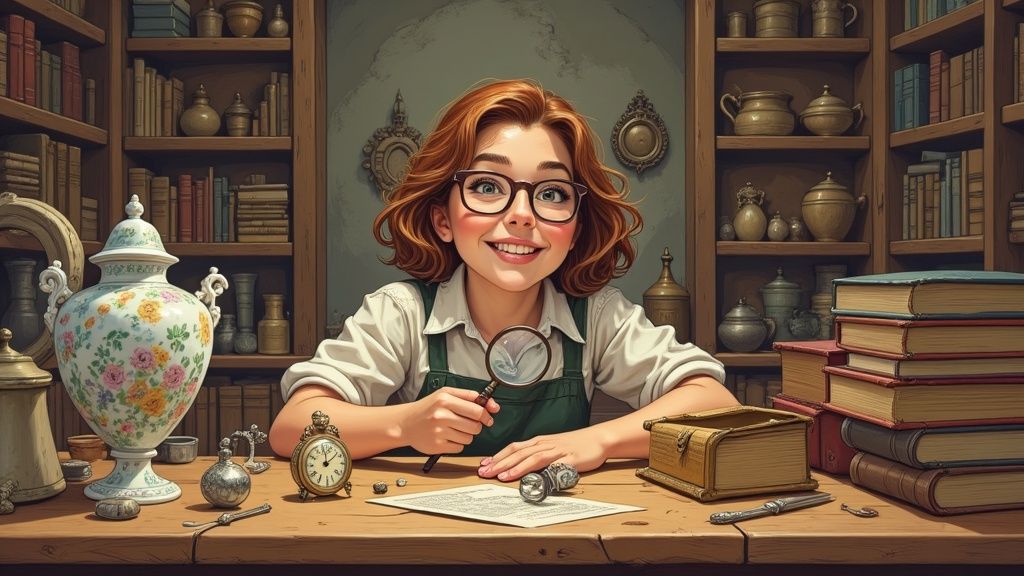So, you’re thinking about getting into antiques. It’s a fantastic world to explore, but it can feel a little overwhelming at first. Where do you even begin when you’re surrounded by centuries of history?
The truth is, collecting isn’t just about buying old stuff. It's a personal journey, a treasure hunt fueled by your own curiosity. Some people are in it for the investment, hoping to find a hidden gem. Others get a thrill from tracking down a specific piece, and many simply want to own a tangible slice of the past. Before you spend a single dollar, take a moment to figure out what truly excites you. That initial spark of passion is what turns a casual interest into a lifelong pursuit.
You don't need to be an expert in everything. In fact, the most successful collectors I know are specialists. They've found their niche. Instead of just browsing for "antiques," they're laser-focused on a category that speaks to them.
Finding Your Collector's Niche
This is the fun part. Choosing a niche gives your hunt a purpose and makes the whole process far more enjoyable. What do you genuinely love? Are you captivated by the elegant, geometric patterns of the Art Deco period? Maybe the simple, rustic charm of early American farmhouse tools calls to you. Your focus can be as broad or as narrow as you want it to be.
To get the wheels turning, here are a few areas that are great for beginners:
- Ceramics and Glassware: This is a huge field, covering everything from delicate porcelain teacups and colorful Depression glass to chunky, durable hotelware.
- Vintage Postcards and Ephemera: A perfect starting point. The cost is low, storage is a breeze, and these little paper treasures offer an incredible window into past lives and places.
- Sterling Silver: You could collect a specific type of item, like intricate spoons or small decorative boxes. A big part of the fun here is learning to decipher the makers' marks and patterns.
- Specific Furniture Periods: Perhaps you're drawn to the ornate, fussy details of Victorian furniture or the clean, minimalist lines of Mid-Century Modern designs.
The real secret is picking a category that fits your budget, your living space, and your passions. Your enthusiasm is the best tool you have—it will drive you to learn, and that knowledge is priceless.
A great way to visualize your options is to compare some popular collecting areas side-by-side.
Choosing Your Collecting Focus
| Collecting Focus | Average Entry Cost | Availability | Key Considerations |
|---|---|---|---|
| Vintage Postcards | $ (Low) | High | Easy to find online and at flea markets. Great for history buffs. Storage is simple. |
| Depression Glass | $ - $$ (Low-Mid) | Medium | Many patterns and colors to choose from. Watch for reproductions and condition issues like chips. |
| Sterling Silver Spoons | $$ (Mid) | Medium | Learn maker's marks and patterns. Silver requires polishing. Value is tied to both silver content and rarity. |
| Mid-Century Modern Chairs | $$$ (High) | Low | Requires significant space. High demand means higher prices. Authenticity and condition are critical. |
This table just scratches the surface, but it shows how different niches come with their own unique opportunities and challenges. Don't be afraid to start small and see what you enjoy hunting for the most.
Setting a Practical Foundation
Once you have an idea of what you want to collect, it's time to get practical. Think about what you're comfortable spending. Some fields, like rare coins or fine art, demand a serious financial commitment right from the start. Others, like vintage kitchen gadgets or postcards, are incredibly accessible. There’s no right or wrong budget—the key is simply to collect within your means and enjoy the process.
This isn't just a niche hobby; it's a global passion. The antiques market is a huge part of the collectibles industry, pulling in an astonishing USD 58.4 billion in revenue in 2024. And it’s not slowing down. Projections point to steady growth, proving that people's fascination with the past is as strong as ever. You can learn more about the thriving second-hand collectibles market and where it's headed.
Ultimately, your collecting journey is your own. My best advice? Start small, stay curious, and, above all, collect what brings you joy. If you follow that simple rule, you'll build a collection that's not just valuable, but deeply and personally meaningful.
Where to Discover Your First Treasures
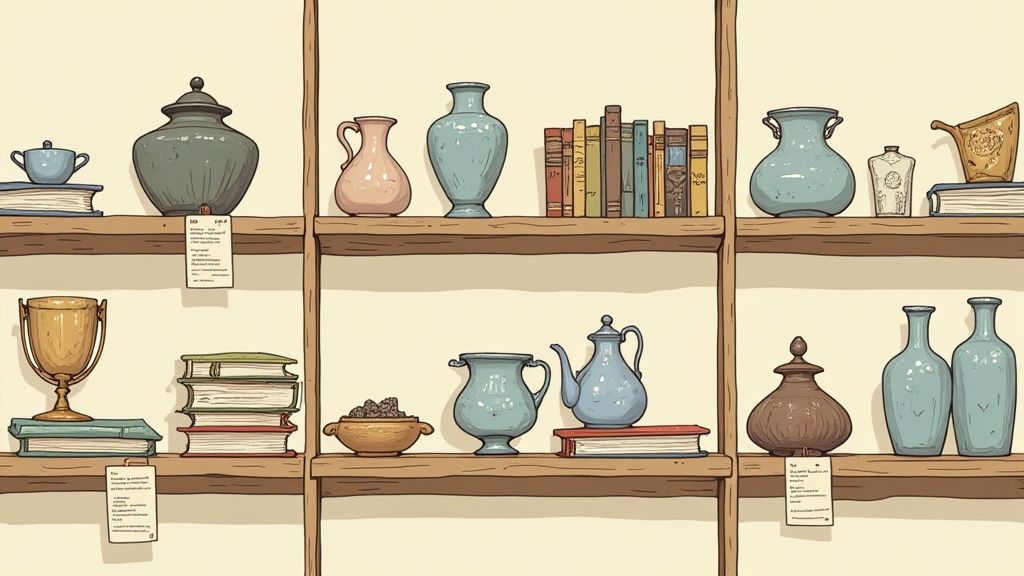
So, you've picked a niche. Now the real adventure begins—the hunt! Finding those first few pieces is one of the most exciting parts of becoming a collector, but knowing where to look is half the battle. Think of it like a treasure map where each location, from the charming chaos of a flea market to the quiet aisles of a local antique shop, offers a completely different experience.
Each spot has its own rhythm and requires a unique approach. A sprawling flea market might hide an incredible bargain, but you'll have to dig through mountains of other stuff to find it. An antique store, on the other hand, does the curating for you, but that expertise usually comes with a higher price tag. Let's break down where you should start your search.
Mastering the Local Hunt
There's a good reason to start close to home: your own community is often brimming with hidden gems. Sourcing locally gives you the priceless advantage of seeing and touching items in person—a crucial step when you're still training your eye to spot quality, fakes, and repairs.
- Antique Shops: Think of these as your classrooms. The items are hand-picked by dealers who (usually) know their stuff, giving you a chance to see what quality looks like up close. Don't be afraid to chat with the owners! Building a good relationship can pay off; they're fantastic sources of knowledge and might even give you a heads-up when something in your wheelhouse comes through their door.
- Flea Markets: Get ready for a sensory overload, but in the best way. For the best selection, show up the moment they open. For the best deals, swing by as vendors are packing up—they’re often willing to negotiate rather than haul everything home. Always bring cash, wear comfortable shoes, and keep an open mind.
- Estate Sales: These sales are a direct window into someone's private collection and life. They are one of the best ways to find items with real history, or provenance. Here's a pro tip: visit on the last day. Prices are often slashed by 50% or more. You risk the best pieces being gone, but you can snag incredible bargains on what’s left.
An antique isn't just an object; it's a story waiting to be discovered. The real value often lies in its history, condition, and rarity. Learning to spot these qualities is key, and you can get a head start by exploring our guide on how to find the value of antiques.
Navigating the Digital Frontier
The internet has completely changed the game for collectors. Online platforms grant you access to a global inventory, but this convenience comes with a catch: you have to be extra vigilant since you can't physically inspect items before you buy.
When shopping online, crystal-clear photos from every angle and detailed descriptions are non-negotiable. Scour the listing for any mention of damage, repairs, or restoration. A reputable seller will always be upfront about an item's true condition.
Here are the main online venues you’ll be exploring:
| Online Venue | Best For | Key Strategy |
|---|---|---|
| Online Auction Sites (e.g., eBay) | Hunting down specific, niche items and getting a feel for market prices. | Be incredibly specific with your search terms. Save searches for items you’re after to get alerts. Always, always check a seller's feedback and return policy. |
| Specialized Marketplaces (e.g., Etsy, Chairish) | Finding curated vintage and antique items, especially for home decor. | These sites tend to have better quality control. Use the filters to your advantage—narrow by style, period, and price. "Favorite" items to get notified of sales. |
| Live Online Auctions | Accessing high-end pieces from traditional auction houses around the world. | Register in advance and make sure you understand the buyer's premium—it's an extra fee added to your winning bid. Set a firm budget and stick to it. Don't get swept up in a bidding war! |
For instance, searching "Syracuse China restaurant ware" on eBay will give you far better results than a vague query like "antique plates." Likewise, filtering for "Art Deco" on a curated site like Chairish will save you from scrolling through thousands of items that don't fit your collection.
By combining on-the-ground detective work with smart online searching, you cast the widest possible net. Every trip to a flea market and every late-night scroll through an online auction is a chance to sharpen your skills. Before you know it, you’ll develop that collector's sixth sense—an instinct for exactly where your next great find is waiting.
How to Authenticate Your Finds
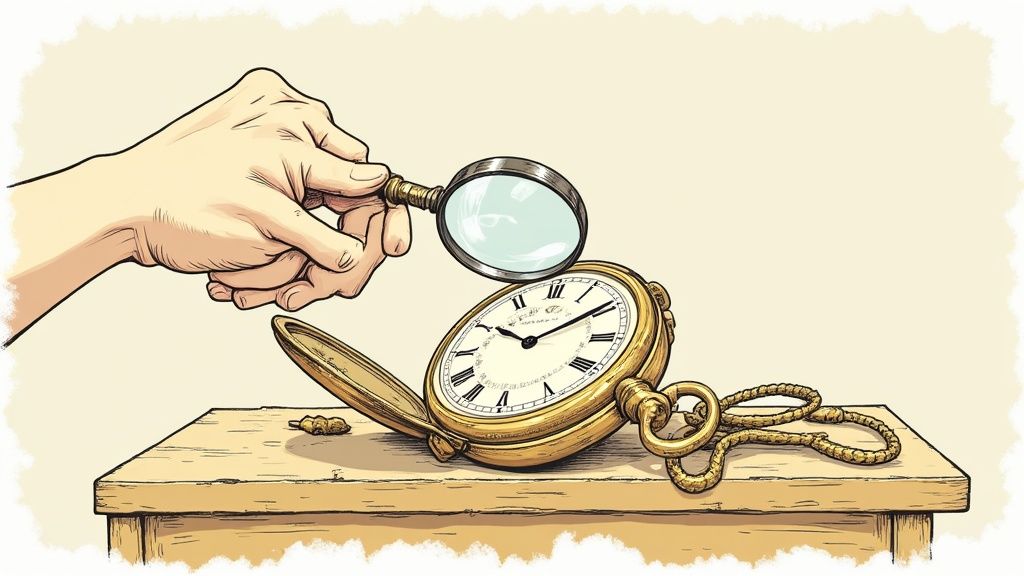
This is the moment that gets every collector's heart racing. You've found something that speaks to you, but is it the genuine article or a clever reproduction? Learning to authenticate your finds is a skill built over time, but it all starts with knowing what to look for. You're about to become a detective, piecing together clues to uncover an item's true story.
Developing your "eye" means training yourself to spot the subtle signs of age that fakes often miss. It’s not just about one single element, but how all the small details—the wear, the materials, the construction—come together to tell a cohesive story. Let's break down the key areas to examine.
Deciphering the Maker's Mark
Your first and most valuable clue is often the maker's mark. This is the small stamp, signature, or symbol that identifies the company, artist, or country of origin. Think of it as the item's birth certificate. On ceramics, you'll usually find it on the bottom. On silver, it could be hidden along a handle or rim.
Not all marks are created equal, and knowing the history behind them is key. For example, a piece of porcelain might be marked "Nippon," which tells you it was made in Japan for export to the U.S. between 1891 and 1921. After 1921, import laws changed, and items had to be marked "Japan." This small distinction is a powerful dating tool.
A word of caution: popular marks are frequently forged. A real mark should show signs of age consistent with the rest of the piece. If the mark looks too perfect or freshly applied on an otherwise worn item, that’s a major red flag.
Reading the Signs of Age and Construction
Beyond the mark, an item's physical characteristics tell a rich story. Authentic antiques have lived a life, and they bear the gentle marks of time. This is where you learn to distinguish between genuine wear and tear and artificial aging.
Here are some specific construction clues I always look for:
- Furniture: Check the joints. Early furniture makers used hand-cut dovetail joints, which are slightly irregular and imperfect. Perfectly uniform, machine-cut dovetails came later. The presence of circular saw marks generally indicates a piece made after about 1860, while straight saw marks suggest it's older.
- Glassware: Flip that piece of hand-blown glass over. You might find a pontil mark—a small, rough scar left when the glassblower broke the piece off the rod. Smoother, more polished bases often point to a later, mass-produced item.
- Ceramics and China: Besides the mark, look at the glaze. Older porcelain may have tiny imperfections like pits or specks of kiln dust trapped in the glaze. The foot rim—the unglazed ring on the bottom—should show some grime and wear from decades of sitting on surfaces.
An antique should look old all over. If the top of a table is heavily distressed but the legs look brand new, be skeptical. Consistent wear is a hallmark of authenticity.
For a deeper dive into specific signs of age across various categories, our detailed guide on how to identify antiques provides a fantastic checklist for your on-the-spot evaluations.
Understanding Patina and Surface Wear
Patina is the soft, mellow sheen that develops on a surface over many years of exposure, polishing, and handling. It's one of the most difficult things to fake convincingly and one of the surest signs of true age.
On bronze or brass, patina appears as a gentle darkening in the crevices. On wood, it's a deep, rich glow that you just can't get from a modern can of stain. Silver develops a dark layer of tarnish in the low points of a pattern, which experienced collectors value highly.
Imagine you find two identical-looking brass candlesticks. One has a uniform, almost unnaturally shiny finish. The other has a darker, almost black tone in the recessed areas and a soft, warm glow on the raised surfaces where it would be touched and polished. The second one is far more likely to be a genuine antique because its patina tells the story of its life.
Never be tempted to over-clean an antique, especially metal. Aggressive polishing can strip away decades of valuable patina and can reduce an item's value by as much as 50%. You have to learn to embrace the signs of age—they are a crucial part of an item's history and appeal.
Getting a Handle on Antique Value and Market Trends
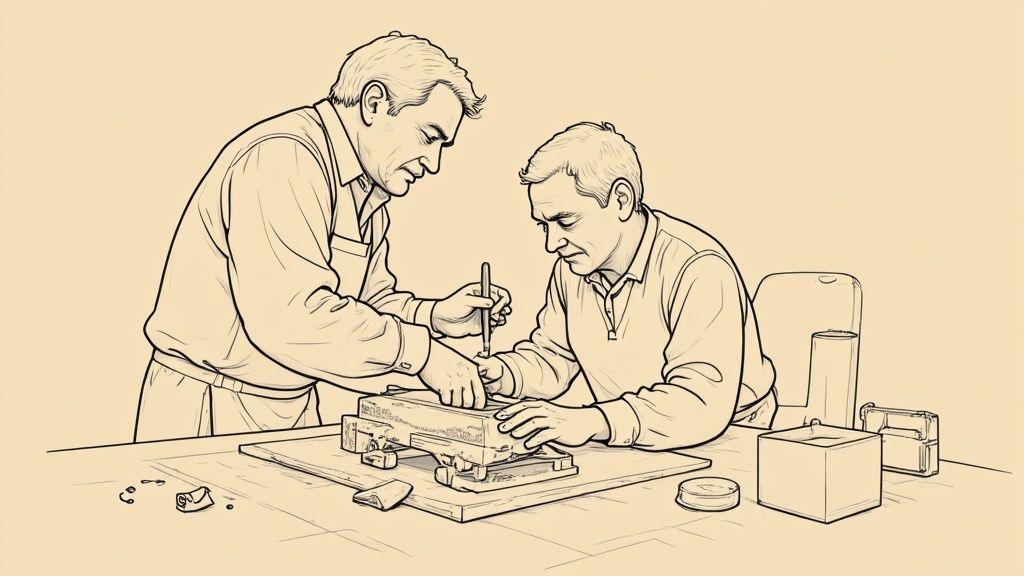
So, you’ve started finding pieces that catch your eye. The immediate next question, the one every collector asks, is: "What's it really worth?" The truth is, there's rarely a simple price tag. An antique's value is a fascinating mix of its backstory, its current physical state, and what the market is excited about right now.
Learning to read these forces is what turns a casual hobbyist into a sharp, confident collector. You aren't just buying an old thing; you're acquiring a piece of history and betting on its future. When you can confidently assess value, you can spot the hidden gems, sidestep the overpriced duds, and build a collection you not only love but that also holds its worth.
The Four Pillars of an Antique's Value
I like to think of an antique's value as a four-legged stool. For it to be stable and hold weight, all four legs—rarity, condition, desirability, and provenance—need to be solid.
- Rarity: Simply put, how many are out there? Something mass-produced by the thousands is almost always going to be less valuable than a piece from a small, limited run. It's the difference between a common factory-made dinner plate and a unique, hand-thrown piece of art pottery from the same period.
- Condition: What shape is it in? Everyone wants "mint condition," but don't get too hung up on perfection. A bit of wear from a century of use is expected and can even add character. It's the major damage—cracks, big chips, clumsy repairs—that can torpedo an item's value.
- Desirability: Who wants it, and how badly? This is all about trends. A certain style of Art Deco furniture or a specific pattern of Depression glass might be all the rage today, only to cool off in a few years. This is the most dynamic and fast-changing of the four pillars.
- Provenance: What's its story? Provenance is the documented history of an item's ownership. A plain antique chair might be worth $50, but if you have solid proof it once belonged to a famous author or politician, its value could leap into the thousands.
These factors are always in conversation with each other. A very rare piece in so-so condition might still command a high price if it's incredibly desirable. Learning to weigh these elements in your head is one of the most important skills you'll develop.
Telling the Difference Between Patina and Damage
This is a big one for new collectors. It’s absolutely critical to learn the difference between acceptable signs of age (what we call patina) and straight-up damage. A 150-year-old chest of drawers should have some scuffs, a mellowed finish, and maybe a few dings. Those marks tell its story.
On the other hand, a deep crack running through a porcelain vase, a glaring chip on the rim of a crystal goblet, or a wobbly furniture leg that's been poorly glued back on is just damage. These are flaws that compromise the piece's integrity and will turn off serious buyers.
A question I always ask myself is, "Does this mark tell a story of gentle use, or does it scream neglect and breakage?" That little mental check can save you from making a lot of expensive mistakes.
Getting a feel for this takes time and seeing a lot of pieces. If you want to dive deeper, our guide on how to value antiques breaks down the specific things to look for.
Keeping an Eye on Market Trends
The antiques market isn't set in stone. It shifts and sways with decorating tastes, cultural moments, and even what’s popular on TV and in movies. What was a hot ticket five years ago might be sitting on shelves today, while a category nobody cared about could suddenly be what everyone wants.
For instance, the antique collecting trends in 2025 are showing a real hunger for pieces that mix historical elegance with top-notch craftsmanship. We're seeing a huge comeback for what you might call "Old-World opulence"—think ornate 17th and 18th-century Baroque and Rococo styles from France and Italy. At the same time, fine china and crystal are back in a big way. Collectors are snapping up heirloom-quality sets from legendary names like Wedgwood, Limoges, Waterford, and Royal Copenhagen for their timeless beauty and storied pasts.
By staying on top of what's happening, you can start to predict what might get hot next. This kind of foresight is a collector's secret weapon, letting you buy smart before prices spike and turning your knowledge into a real asset.
Caring For Your Collection Like a Pro
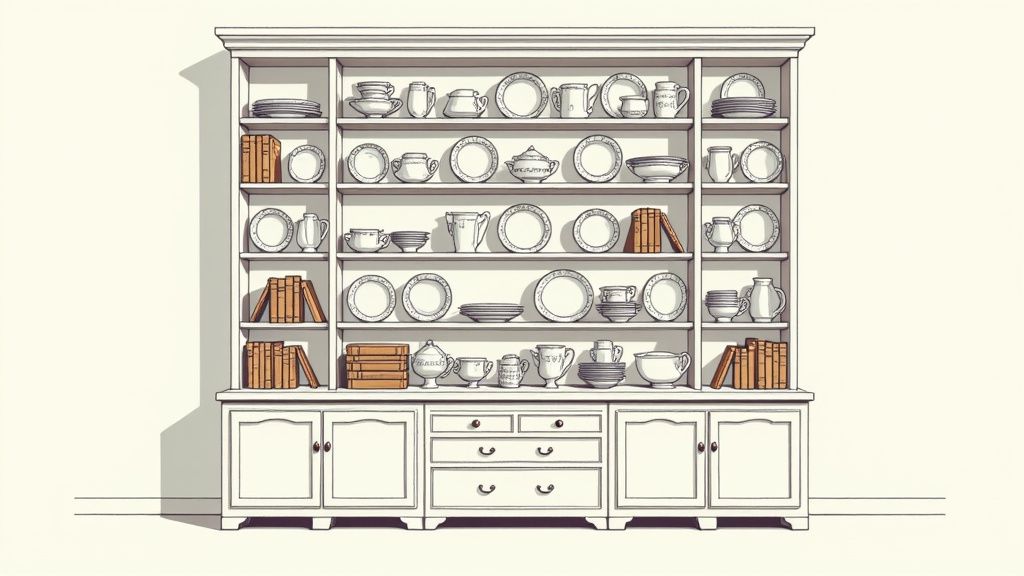
So, you've brought home your first treasure. That's a huge milestone! After the initial excitement, a new feeling often sets in: responsibility. You're now the custodian of a piece of history, and it's up to you to make sure it lasts for generations to come.
Proper care is one of the most crucial parts of antique collecting for beginners. But this isn't about making things look shiny and new. In fact, over-restoring an item can tank its value. The real goal is preservation—protecting your collection from subtle dangers like sunlight and humidity by using the right techniques for each material.
With a little know-how, you'll become a confident guardian of your collection.
The Gentle Art of Cleaning Antiques
Before you reach for that all-purpose cleaner under your sink, stop. Harsh, modern chemicals are the enemy of antiques and can strip away an item's history (and its value) in seconds. When it comes to cleaning, the golden rule is simple: always start with the mildest method first.
For routine dusting, a soft, dry microfiber cloth is your best friend. But when it's time for a deeper clean, different materials need different handling.
Antique Wood: Never, ever soak antique wood. Instead, get a soft cloth, lightly dampen it with a mild soap and water solution, and wring it out until it’s almost dry. Gently wipe the surface and immediately follow up with a separate clean, dry cloth.
Antique Silver: See that dark tarnish in the crevices? That’s called patina, and it's a desirable sign of age. Don't try to obliterate it with abrasive polishes or chemical dips. A high-quality silver polishing cloth is usually all you need to bring back the shine on the high points while preserving that beautiful, dark patina.
Porcelain and Glass: Always wash these pieces by hand, one at a time. It’s a good idea to place a plastic tub in your sink to avoid chipping the item against a hard ceramic or metal surface. Use lukewarm water with just a drop of mild dish soap, and never, ever put antique china or glassware in the dishwasher.
Protecting Your Finds From the Environment
Some of the biggest threats to your antiques are completely invisible. Your home’s environment can cause serious, irreversible damage over time, from cracked wood to faded fabrics and rusted metal.
Your goal is to create a stable environment. Extreme fluctuations in temperature and humidity are far more damaging than conditions that are consistently a little too high or too low.
Keep these three environmental factors in mind:
Light: Direct sunlight is a killer. Its UV rays can bleach wood finishes, fade the vibrant colors in paintings and textiles, and make materials brittle. Position your most precious items well away from sunny windows.
Humidity: The sweet spot for most antiques is a humidity level between 45% and 55%. Too much moisture can swell wood, rust metal, and encourage mold. Too little will cause wood to shrink, split, and crack. You can easily monitor the levels in a room with a simple hygrometer.
Temperature: Keep your antiques away from radiators, heating vents, and fireplaces. The constant cycle of heating up and cooling down can cause furniture joints to loosen and delicate veneers to bubble and lift.
Displaying Your Collection Safely
The best part of collecting is getting to live with your finds. Displaying them safely is all about blending smarts with style—you don’t need to hide your pieces away to protect them.
A sturdy china hutch with glass doors, for instance, is perfect for showing off delicate ceramics while protecting them from dust and accidental bumps. When you hang an antique mirror or a piece of art, use proper picture-hanging hardware that’s rated for the item’s weight. Please, don’t just use a single nail.
And remember, some things were made to be tough! If you collect something like vintage hotelware, which was built for constant use, don't be afraid to actually use it. Stacking those sturdy platters on open kitchen shelves looks fantastic and makes it easy to grab one and enjoy it every day. By mixing careful cleaning with thoughtful placement, you’ll keep your collection beautiful and safe for years to come.
Common Questions from New Collectors
Diving into the world of antiques can feel a lot like learning a new language. As you start out, it's completely normal for questions to pop up everywhere—from the flea market aisle to your own living room. Getting good, straightforward answers is what builds the confidence you need to make smart decisions and really enjoy the hunt.
We've pulled together some of the most common questions we hear from people just getting their start. Think of this as your go-to guide for those first few hurdles.
How Do I Know If I'm Paying a Fair Price?
This is the big one, isn't it? The fear of overpaying is real, but you have more tools at your disposal than you might think. Figuring out a fair price isn't magic; it's just a little bit of homework.
Before you commit, do a quick "comps" search right there on your phone. Look up similar items on sites like eBay, but here's the key: filter the results to see what items have actually sold for, not what sellers are asking. This gives you a real-time snapshot of the current market value. Appraisal apps can also give you a quick estimate and a bit of backstory on an item.
And please, don't be afraid to negotiate. At flea markets, antique shops, and estate sales, it's not just accepted—it's expected. Be polite and respectful, of course, but most sellers build a little wiggle room into their prices.
What's the Biggest Mistake Beginners Make?
Hands down, the most common pitfall is the impulse buy. You spot something that looks old and fascinating, get swept up in the thrill of the find, and buy it without a second thought. It's only later you realize it's a reproduction, it's in terrible shape, or it just doesn't fit with the collection you're trying to build.
The best way to avoid this is to create a simple mental checklist before you pull out your wallet. Ask yourself:
- Condition: Have I really looked it over for cracks, chips, or shoddy repairs?
- Authenticity: Are there any maker's marks? Does it show signs of genuine age and wear?
- Fit: Does this piece actually work with what I've decided to collect?
Taking a few seconds for a calm, honest assessment can save you a world of buyer's remorse. It's always better to walk away from a "maybe" and hold out for a definite "yes."
Do I Need Insurance for My Antique Collection?
The short answer is: it depends on what your collection is worth. Your standard homeowner's or renter's policy usually offers some coverage for personal belongings, but it often has a pretty low limit—typically around $1,500 to $2,500 for categories like antiques.
If your collection's value starts climbing past that number, it's time to look into specialized insurance. As your collection grows, it's a great idea to get a professional appraisal for your most valuable pieces. This paperwork is crucial for getting the right amount of coverage.
Insuring your collection isn't just about the money; it's about peace of mind. Knowing your investment is protected lets you get back to the joy of collecting.
The market itself is recognizing the need for this kind of security. Investment trends in collectibles for 2025 highlight a growing appreciation for antiques as tangible assets, especially when the economy feels uncertain. The rise of digital platforms and trusted auction houses has made authenticated antiques more accessible, making it easier for new collectors to jump in with confidence. You can dig deeper into these key investment trends on Collect-Insure and see how antiques are stacking up against other valuable collectibles.
Ultimately, by asking the right questions and knowing where to find good information, you empower yourself to build a collection that's not only beautiful and historic but also smart and secure.
Ready to uncover the story behind your own finds? With Curio, you can turn any mysterious object into a known treasure. Snap a photo to instantly learn an item's history, origin, and estimated value. Download Curio today and start your journey from curious collector to confident expert. Get started with Curio.
